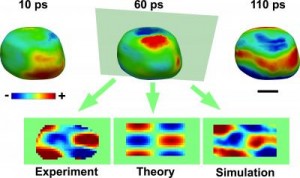I tend to forget how new nanotechnology is and unconsciously take for granted stunning feats such as measuring a metallic nanoparticle’s electronic properties. A June 15, 2015 news item on Nanowerk provides a reminder with its description of the difficulties and a new technique to make it easier (Note: A link has been removed),
How do you measure the electronic properties of individual nanoparticles or molecules that are only a few nanometers in size? Conventional methods using electron transport spectroscopy rely on contacting a material with two contacts, a source and a drain electrode. By applying a small potential difference over the electrodes and monitoring the resulting current, valuable information about the electronic properties are extracted. For example if a material is metallic or semiconducting.
But this becomes quite a challenge if the material is only a few nm in size. Even the most sophisticated fabrication tools such as electron-beam lithography have a resolution of about 10 nm at best, which is not precise enough. Scientists have developed workarounds such as creating small gaps in narrow metallic wires in which a nanoparticle can be trapped if it matches the gap size. However, even though there have been some notable successes using this approach, this method has a low yield and is not very reproducible.Now an international collaboration including researchers in Japan, the university [sic] of Cambridge and the LCN [London Centre for Nanotechnology] in the UK have approached this in a different way as described in a paper in Nature’s Scientific Reports (“Radio-frequency capacitance spectroscopy of metallic nanoparticles”). Their method only requires a single electrode to be in direct contact with a nanoparticle or molecule, thus significantly simplifying fabrication.
A June 15, 2015 (?) LCN press release, which originated the news item, describes the achievement,
The researchers demonstrated the potential of the radio-frequency reflectometry technique by measurements on Au nanoparticles of only 2.7 nm in diameter. For such small particles, the electronic spectrum is discrete which was indeed observed in the measurements and in very good agreement with theoretical models. The researchers now plan to extend these measurements to other nanoparticles and molecules with applications in a range of areas such as biomedicine, spintronics and quantum information processing.
Here’s a link to and a citation for the paper,
Radio-frequency capacitance spectroscopy of metallic nanoparticles by James C. Frake, Shinya Kano, Chiara Ciccarelli, Jonathan Griffiths, Masanori Sakamoto, Toshiharu Teranishi, Yutaka Majima, Charles G. Smith & Mark R. Buitelaar. Scientific RepoRts 5:10858 DOi: 10.1038/srep10858 Published June 4, 2015
This is an open access paper.
![Figure: Artist’s impression of a hot gas of magnetic monopoles in very cold surroundings. Eventually the surroundings suck the heat out of the monopole gas leaving it frozen at low temperature. [downloaded from http://www.london-nano.com/research-and-facilities/highlight/frozen-magnetic-monopoles-create-new-laboratory-physics]](http://www.frogheart.ca/wp-content/uploads/2014/01/FrozenMagneticMonopoles--230x300.jpg)
